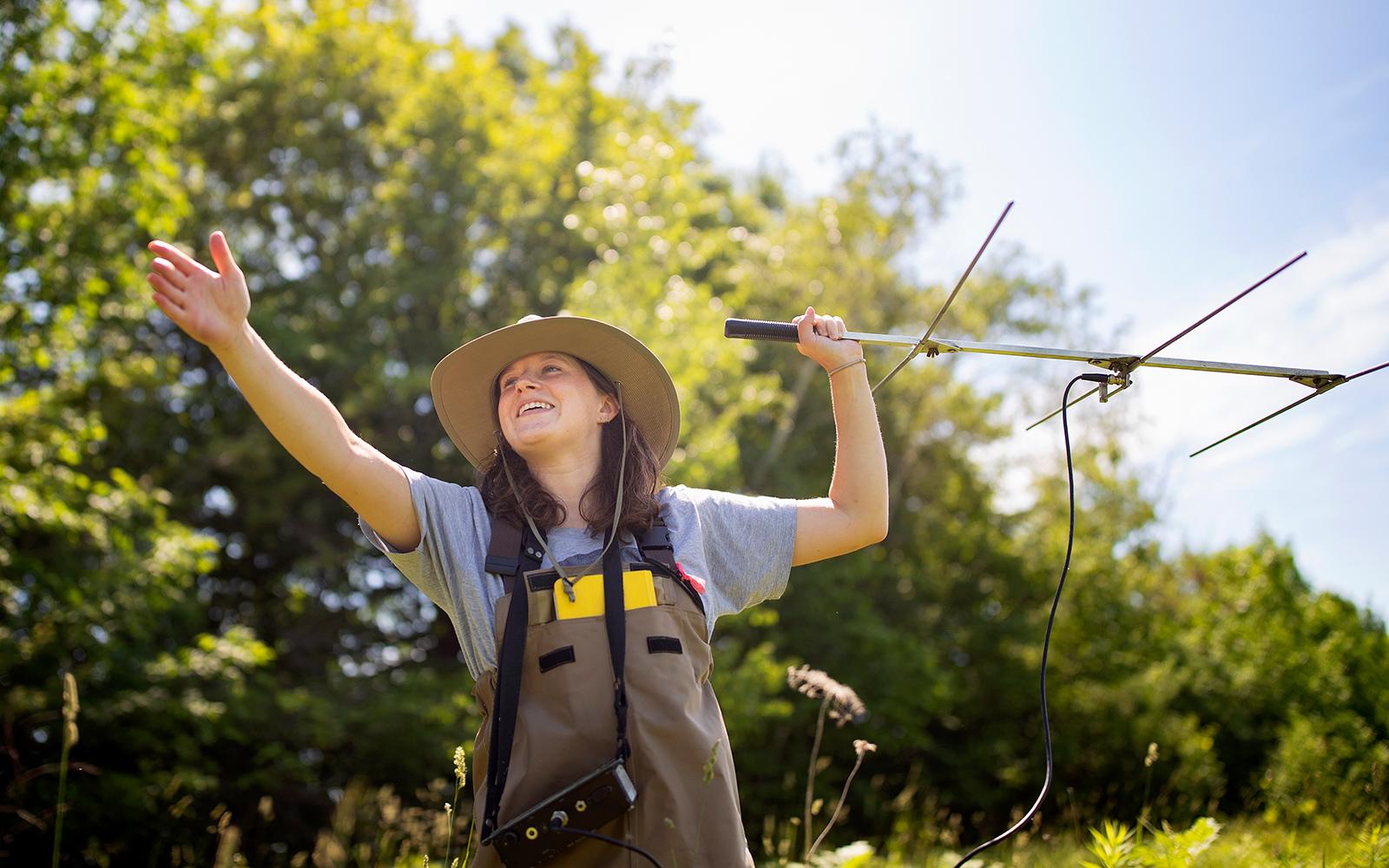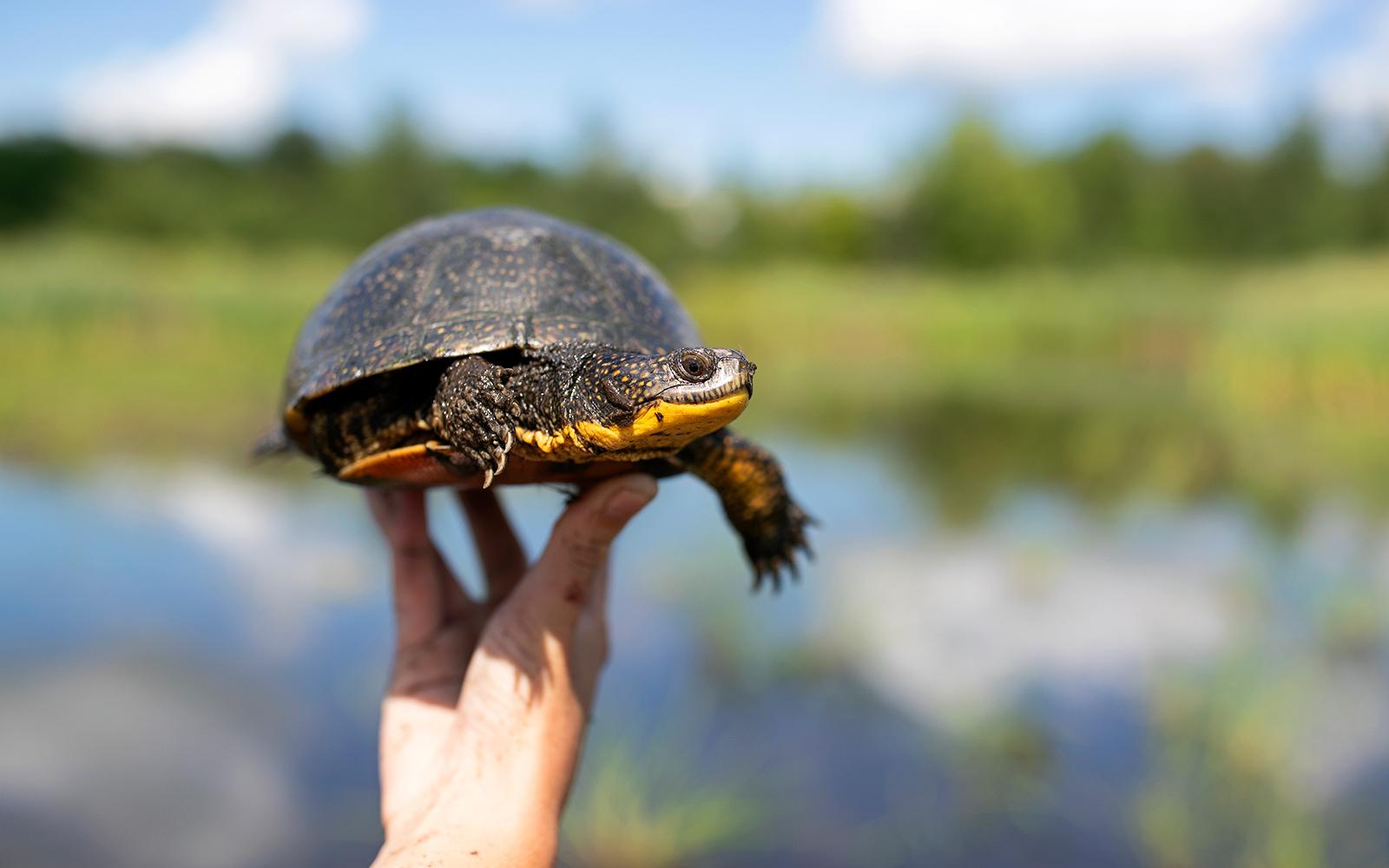From the beaches of Long Island to the mountains of Northern New York, Grace Conway ’24 jumped at the opportunity for a change in scenery when she graduated from high school. Now she’s pursuing a degree in environmental studies at SUNY Potsdam, and after just one year at the College, she's already receiving grant funding to conduct research on threatened Blanding’s turtles.
In high school, Conway planned on attending SUNY Plattsburgh, but during a road trip to look at colleges, a visit to SUNY Potsdam sent her down a different path.
“I had signed up for a meeting with one of the admissions counselors here at SUNY Potsdam and he talked about the Adirondack Experience. I was so interested in that program, and I didn’t hear about anything like that at any of the other schools,” Conway said. “I just got a really good feeling about SUNY Potsdam—I was hooked immediately.”

Grace Conway ’24 uses a telemetry receiver to try to locate a Blanding's turtle in Lisbon, N.Y.
For the Long Island native, SUNY Potsdam provided a welcome contrast to the coastal living in which she had grown accustomed. She immediately enrolled in the College’s Adirondack Experience program—an opportunity for first-year students to take three interdisciplinary courses with a common environmental studies theme, and then explore the six-million-acre Adirondack Park.
Combining Introduction to Environmental Studies with Dr. Kate Cleary, Adirondack Ecology with Dr. Glenn Johnson and Writing in the Adirondacks with Dr. Donald McNutt, Conway wasted no time learning about her new surroundings, and the breathtaking wilderness just a short drive from campus. Every Friday during the Fall 2020 semester, she set out on new adventures to explore different ecosystems, everything from the summit of Mount Arab, Lampson Falls, and the Spring Pond Bog, to Cranberry Lake.
“I came in knowing that I wanted to do environmental studies after hearing the admissions counselor talk about the different majors and the Adirondack Experience. I found a lot of footing through that program—especially Intro to Environmental Studies where we had a whole unit on jobs and future careers in the outdoors,” she said.
A trip to Cranberry Lake reinforced her decision. She remembers stepping out on the peat moss as she explored the wetlands alongside lake, the third-largest body of water in the Adirondacks. For a first-year student entering college during the global pandemic, the Adirondack Experience also offered a welcome respite from her Zoom classes and pooled saliva testing. “Those were my only three classes that were in person. I was just so excited that we were able to go out and explore all the different areas up here, that are so different from the beach environment that I’m used to. That was awesome,” Conway said.
In the Spring of 2021, her hands-on education continued after meeting Grace Romer ’24, another first-year student on campus who was conducting a research project for the general honors program. Romer had set up motion-activated cameras to monitor wildlife, and Conway became her enthusiastic assistant. Together they installed stakes to track the height of animals passing through SUNY Potsdam’s Lehman Park, and every two weeks they returned to the park to collect SD cards and review the images of wildlife.
Building on that experience, Dr. Johnson told Conway about a SUNY Research Foundation grant, an opportunity for her to receive funding to help him with ongoing efforts to protect Blanding’s turtles in Northern New York. Conway teamed up with Dana Holmlund ’21 and Gabby Toriseva ’23 on several projects to help the threatened species. The trio has been spending their days wading through swamps using telemetry receivers to pinpoint the location of the slow-moving reptiles. Once found, they record their location and swap out GPS monitors tracking the turtles’ nesting patterns.
At night, they shifted gears and spend hours monitoring female turtles arriving at one of four sandy nesting sites in Lisbon, or two other sites in Waddington and Massena. “We’re there until the last turtle leaves,” Conway said. “Whenever she wants to head out, that’s when we go. One time we were there until 2 a.m. The female turtle was taking a while, just checking around the site to see where she wanted to lay her eggs. She ended up not even nesting that night.”
When the female turtles do nest, Conway, and Johnson’s other research assistants, are responsible for locating the eggs, often buried deep in the sand, and installing protective fencing. That technique, coupled with an electric fence that runs around the perimeter of the sandpits, allows the turtles to pass unobstructed while keeping predators at bay.
It’s not a task for the impatient as the shelled reptiles move at their own pace, ambling along in search of the perfect nesting locations. Without the intervention of Conway and her peers—skunks, raccoons, and other predators present a very real danger to the Blanding’s turtles.

A Blanding's turtle in Lisbon, N.Y.
“Seeing these naturally occurring sandpits is really cool too, I’ve never studied anything like that,” Conway said. “I really like the hands-on experience and learning all of these different techniques.”
After the nesting season ends in July, Conway moves into a new phase of the project, going through hundreds of photographs—taken once every minute at the nesting sites—to further analyze the nesting patterns of Blanding’s turtles.
With unrivaled hands-on research opportunities early in her college career, the sky is the limit for Conway. Like the spongy moss she examined at Cranberry Lake last fall, she will continue absorbing knowledge from her professors at SUNY Potsdam, and laying the groundwork for a career in environmental studies.
For more information about the Department of Environmental Studies, visit: https://www.potsdam.edu/academics/AAS/depts/EnvStudies
Article and photos by Jason Hunter
